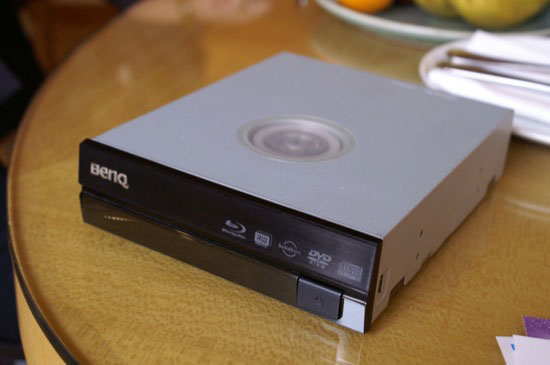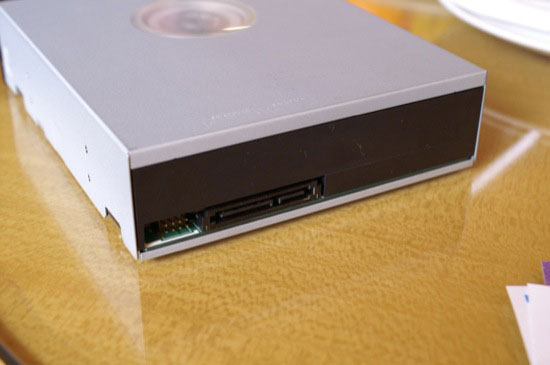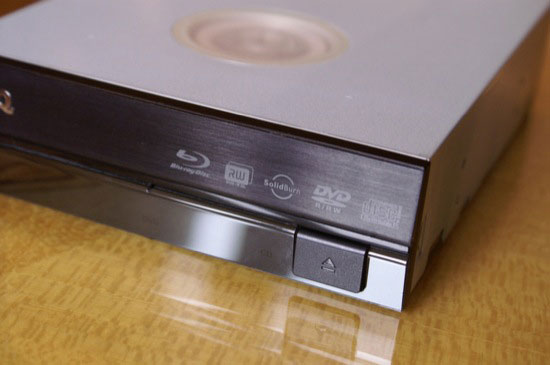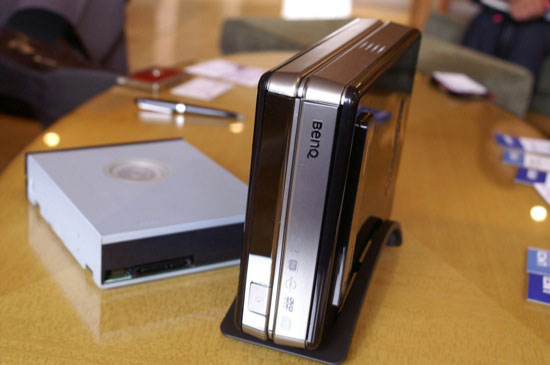Computex 2006: 300W GPUs, Conroe, HDMI Video Cards and Lots of Motherboards
by Anand Lal Shimpi on June 5, 2006 10:24 PM EST- Posted in
- Trade Shows
BenQ: Status of Blu-ray and SATA Optical Drives
We talked at great length with BenQ about the current lack of Serial ATA optical drives. While SATA optical drives don’t offer any real performance advantage over PATA drives, there are other factors that are driving our demand for and interest in the units. Intel’s new I/O Controller Hub used in the 965 (Broadwater) chipsets, ICH8, doesn’t natively support any PATA ports; motherboard manufacturers have to resort to a 3rd party controller to offer one PATA port. It’s clear that Intel wants to be rid of PATA, and with 6 - 8 SATA ports on new motherboards these days the time to transition entirely to SATA is now.
Unfortunately, as BenQ tells us, the same desire to transition to SATA doesn’t exist with the Tier 1 OEMs that are building systems using these optical drives. Apparently there are still a number of compatibility issues with the default Windows driver and many SATA optical drives, which has made the big OEMs wary of moving away from tried and true PATA drives. With very little OEM pressure to transition to SATA optical drives, manufacturers like BenQ have no reason to push for a quicker move to SATA.
BenQ said to expect less than 5% of its drive shipments by the end of this year to be SATA; by the middle of next year that number will thankfully grow to 25%.
With DVD readers and recorders quickly dropping to commodity price levels, the new focus of optical drive makers is on Blu-ray and HD-DVD. BenQ is exclusively producing Blu-ray drives and its representatives showed us the first two Blu-ray drives that will debut later this year. The BW1000 is offered in both an internal and an external variety, both featuring a 2X read/write speed for Blu-ray media. Dual layer Blu-ray media will be written to at 1X.
The drives also feature a LED indicator telling you what sort of media you’ve got in the drive (e.g. Blu-ray or DVD). The internal drive will carry a price tag of around $700 when it debuts in July. The Optical Pickup Unit in a Blu-ray drive can cost around 20x that of the OPU in a DVD drive, which contributes to the incredibly high cost.
BenQ stated that you may be able to upgrade these 2X drives to 4X drives with a firmware update later on, but it’s too early to tell for sure. The first native 4X Blu-ray drives from BenQ will arrive in Q1 of next year.















61 Comments
View All Comments
phusg - Tuesday, June 6, 2006 - link
No, transparent side windows already did that ;-)
OCedHrt - Tuesday, June 6, 2006 - link
So what happened to ASRock boards (supposedly page 18)?bongobear - Tuesday, June 6, 2006 - link
I'd like to see what ASRock have lined up as well, however the mini-ITX Albatron boards that were shown in their place were a nice surprise. If they can tweak those a little and get them out at a nice price, very tempting....JarredWalton - Tuesday, June 6, 2006 - link
Anand has a ton of pictures and information from his trip, so he'll probably provide a second update later. However, I've updated the page links to correctly reflect the Albatron content on page 17.Stele - Tuesday, June 6, 2006 - link
There are actually two major types, one (the more common) being filled with solid compound as noted, and are simply called solid electrolytic, or solid aluminium electrolytic capacitors. The other type uses non-solid electrolyte. Both types are better than the usual electrolytic capacitors of course in terms of resistance to high temperatures - generally around 1,500-3,000 hours at 105°C-125°C. Another useful characteristic is that they perform well in high-frequency, high-capacitance applications, which is one reason they've often been used on graphics cards, for example.
They are however not immune from leaking and other capacitor related failures... it's just that they can survive prolonged exposure to higher temperatures for longer periods of time than the regular electrolytic capacitors before they too fail.
This, unfortunately, is non sequitur i.e. it does not follow. Component choice is but one of so many factors in determining the stability, performance and reliability of a product. A cheapo backyard manufacturer could boast 16-phase power, all-Nichicon/Rubycon solid electrolytic caps, Philips MOSFETs and AMP connectors all around but would still fail if the circuits were designed by a half-baked engineer fresh out of college and poorly manufactured. Of course, it could be used by the said cheapo manufacturer as a gimmick to fleece the gullible consumers (of which unfortunately there are very many) who rocket to seventh heaven on seeing such big names. Or a not-so-cheapo manufacturer could make their product more attractive by using such flash while cutting corners on areas where consumers probably won't notice in perhaps the first 6 months of use.
Speaking of gimmick, as mentioned above these capacitors are more useful in high-frequency, high-temperature applications. Naturally not every single circuit nor square inch of a motherboard would call for them and hence the extra cost of 100% solid electrolytic capacitors is unnecessary - they cost in the order of 3-5 times that of regular electrolytic caps, and when added up the savings could certainly be better used elsewhere on the board. For now, at least, other than the circuitries that really could benefit from the solid electrolytic capacitors, I would agree with the other manufacturers that indiscriminate plastering of the board with them is rather more marketing gimmick than engineering.
Viditor - Tuesday, June 6, 2006 - link
Anand/Jarred...I have a few questions if you get time.1. How is the RAS functionality for Woodcrest with the Asus server board?
2. Do the FBDIMMs require active cooling, and if so how much?
3. When Asus released the A8N32-SLI, they hinted at releasing more boards with the 8 phase power...have/will they?
4. Any chance on finding out what the functionality is for the 1207 pins on Socket F?
Cheers! And thanks for the article...!
bob4432 - Tuesday, June 6, 2006 - link
after all this time and the floppy still lives on ...... ;)Calin - Tuesday, June 6, 2006 - link
Floppy is still the only way to load certain drivers for hard drive controllers in Windows (during installation). And as long as this will be the case, the floppy will live onDigitalFreak - Tuesday, June 6, 2006 - link
Fortunately, this problem goes away with Vista. I'm hoping that in a couple of motherboard revs, those damn things will go away.JarredWalton - Tuesday, June 6, 2006 - link
I linked in higher res images for some of the more interesting photos Anand took. If you would like to see any others in more detail, let me know (via email) and I will see about adding those. Note that some images are left in "lo-def" because it reduces blurriness. :)Take care,
Jarred Walton
Editor
AnandTech.com